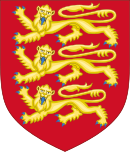East Midlands | |
|---|---|
From top, left to right: Northampton; Leicester; Nottingham; Derby; Sherwood Forest; Lincoln Cathedral; Rutland Water; Peak District | |
 East Midlands shown within England | |
| Coordinates: 52°59′N 0°45′W / 52.98°N 0.75°W | |
| Sovereign state | United Kingdom |
| Country | England |
| GO established | 1994 |
| RDA established | 1998 |
| GO abolished | 2011 |
| RDA abolished | 31 March 2012 |
| Subdivisions |
35 districts
|
| Government | |
| • Type | Local authority leaders' board |
| • Body | East Midlands Councils |
| • MPs | 46 MPs (of 650) |
| Area | |
| • Total | 6,105 sq mi (15,811 km2) |
| • Land | 6,032 sq mi (15,624 km2) |
| • Rank | 4th |
| Population (2022)[3] | |
| • Total | 4,934,939 |
| • Rank | 8th |
| • Density | 820/sq mi (316/km2) |
| Ethnicity (2021) | |
| • Ethnic groups | |
| Religion (2021) | |
| • Religion | List
|
| Time zone | UTC+0 (GMT) |
| • Summer (DST) | UTC+1 (BST) |
| ITL code | TLF |
| GSS code | E12000004 |
| This article is part of a series within the Politics of the United Kingdom on the |
 |
|---|
The East Midlands is one of nine official regions of England. It comprises the eastern half of the area traditionally known as the Midlands. It consists of Derbyshire, Leicestershire, Lincolnshire (except for North Lincolnshire and North East Lincolnshire), Northamptonshire, Nottinghamshire, and Rutland. The region has a land area of 15,624 km2 (6,032 sq mi), with an estimated population 4,934,939 in 2022.[3] With a sufficiency-level world city ranking, Nottingham is the only settlement in the region to be classified by the Globalization and World Cities Research Network.[5]
The region is primarily served by East Midlands Airport, which lies between Derby, Leicester and Nottingham. The main cities in the region are Derby, Leicester, Lincoln and Nottingham. The largest towns in these counties are Boston, Chesterfield, Coalville, Corby, Glossop, Grantham, Kettering, Loughborough, Northampton, Mansfield, Oakham, Swadlincote and Wellingborough.
- ^ "Our Work". East Midlands Councils. Retrieved 10 August 2024.
- ^ "Standard Area Measurements (Latest) for Administrative Areas in the United Kingdom". Open Geography Portal. Office for National Statistics. 24 April 2024. Retrieved 6 May 2024.
- ^ a b "Mid-Year Population Estimates, UK, June 2022". Office for National Statistics. 26 March 2024. Retrieved 3 May 2024.
- ^ a b UK Census (2021). "2021 Census Area Profile – East Midlands Region (E12000004)". Nomis. Office for National Statistics. Retrieved 14 August 2023.
- ^ "GaWC - The World According to GaWC 2020". www.lboro.ac.uk. Retrieved 25 January 2022.







